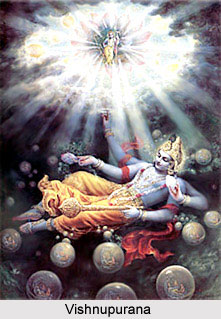 Vishnu Purana, also known as the Puranratna, or the gems of Puranas, is one among the eighteen major Indian Puranas. It is the sacred text of the Vaishnava branch of Hinduism. In this work Vishnu is praised and glorified as the highest being, as the one and only god, with whom Brahma and Lord Shiva are one, and as the creator and preserver of the world. Similar to the other Puranas, the Vishnu Purana also narrates the story of the creation of Cosmos to its destruction at the end. The text of Vishnu Purana opens with the introduction of the four Yugas at the beginning of the text. In addition to these, there are widespread sections on lineage of the celebrated kings, heroes and demigods of ancient India, including those from the epics of Ramayana and Mahabharata. It has been enumerated in the text of Vishnu Purana, if a man gives as a gift a book of Vishnu Purana on the full-moon day in the month of Asadha (July) with Jaladhenu he will attain the sacred Vishnupada.
Vishnu Purana, also known as the Puranratna, or the gems of Puranas, is one among the eighteen major Indian Puranas. It is the sacred text of the Vaishnava branch of Hinduism. In this work Vishnu is praised and glorified as the highest being, as the one and only god, with whom Brahma and Lord Shiva are one, and as the creator and preserver of the world. Similar to the other Puranas, the Vishnu Purana also narrates the story of the creation of Cosmos to its destruction at the end. The text of Vishnu Purana opens with the introduction of the four Yugas at the beginning of the text. In addition to these, there are widespread sections on lineage of the celebrated kings, heroes and demigods of ancient India, including those from the epics of Ramayana and Mahabharata. It has been enumerated in the text of Vishnu Purana, if a man gives as a gift a book of Vishnu Purana on the full-moon day in the month of Asadha (July) with Jaladhenu he will attain the sacred Vishnupada.
Origin of Vishnu Purana
In the Vishnu Purana the reference of the Maurya Empire is found. Hence the scholars have surmised it to be composed in the first or second century AD.
Composition of Vishnu Purana
It is divided into six Adisas or Khandas or chapters. It deals with the events of Varahakalpa and contains 23,000 Shlokas. Its character is more that of a unified composition than of a mere compilation, which the case with most of the other Puranas is. It has been narrated by the narrator himself that Vyasa, adept in the composition of Puranas, composed this Puranasarirhita with akhyanas, upikhyanas, githas and kalpanirnayas. A Suta named Romaharsana was Vyasa`s chief disciple. Vyasa in order to propagate his teachings among his disciples gave that Samhita to that Suta. Romaharsana had six disciples named Sumati, Agnivarcas, Mitrayus, Sarhsapiyana, Akrtavrana and Savarni. Of these, Akrtavrana, Savarni and Sarhsapiyana born in the Kasyapagotra have composed Puranasamhitas, which are based on the teachings of Vyasa described in Samhita. There is yet another Samhita composed by Romaharsana which became the basis of the sarirhitas of his three disciples. The narrator says that he composed the Vishnu Purana based on the above four Samhitas.
Content of Vishnu Purana
The main text of Vishnu Purana opens with the conversation between a sage and a disciple. The method of narration is in the form a conversation, where the sage Parasar teaches his disciple Maitreya. The text of Vishnu Purana is compiled into six parts. The first part narrates the creation of the universe, Pralay and the churning of the sea. The second part contains a geographical description of the earth when it divided into seven islands, after the churning of sea. The third part describes the origin of Buddhism. The fourth part contains a description about the inhabitants of the earth from the beginning of its creation. The fifth part is entirely devoted to the life and plays of Lord Krishna. The sixth part contains the description of religion in Kali Yuga. Thus the Vishnu Purana in its three parts demonstrates the Universe, from its creation till its destruction.
The ultimate note of the Vishnu Purana is that the forfeiture in the feet of Lord Vishnu will lead a man to get rid of all mortal bondages and sufferings. As a result the man will attain salvation. The Vishnu Purana thereby touches the keynote of the entire Puranas.



















